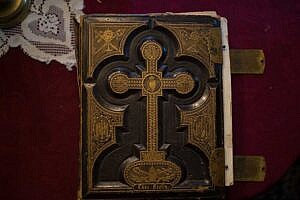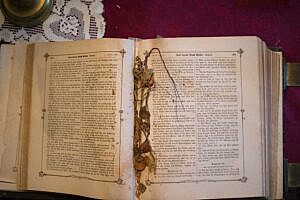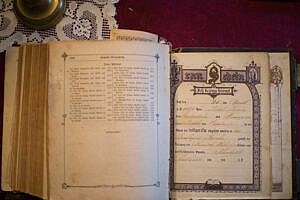Books store many things. They carry sentences, ideas, stories. Their material form may also hold objects. Photos, memorial pictures, even dried plants may be saved there. Books defy time and may become memorabilia themselves. The Family Bible Kaelin-Lienhard is such a memory trove.
We are sitting in the living room of Barbara Liebert Carrico. Her brother Jordan Liebert tells about the family's history. Karl Kaelin was his great-grandfather. He had come to Louisville in 1865 and some years later married Josephina Meinrada Schoenbechler, from Einsiedeln also. They had ten children. Most of them were to marry within the local German-speaking community. Barbara's and Jordan's grandmother married Henry Richard Liebert, son of a German family of milk farmers who in 1850 had arrived from Hessen in Louisville. Various marriages within existing relationships complicate the story. Even Barbara seems to have difficulties finding her way in the genealogical thicket, and similarly her guests from Switzerland with their bumpy English. Jordan however always keeps afloat.
Jordan shows us the Family Bible. It is an imposing book, with heavy wooden covers and metal fittings. His grandmother Rose, a very pious woman, as he remarks, had inherited the Bible from her father and treasured it throughout her life – she died in 1983 at age 103. The Bible had come to him by way of an aunt who some years ago had to move to an old people's home. The book is a treasure trove. Between pages hide old photos, devotional pictures, and again quite often dried leaves and flowers. The plants were a kind of mementos, Jordan explains. In earlier times one occasionally took a little plant along from a burial, a wedding, or another important event and then put it as a kind of memento between the pages of an important religious book.
The book gives us many hints about the life of earlier Swiss immigrants. It tells for instance about assimilation. The first owner had his name engraved on the book cover, and that in the American, not in the European way: “Chas Kaelin", not "Karl Kälin". The Bible text is in German, but the picture legends are in English. The book also reveals the importance of the Church in the life of many Catholic immigrants. There is for instance a printed marriage certificate on which only the empty spaces had to be filled out, and it also had places for pasting pictures or noting dates of birth, death and other events. The message: One was not to be Catholic during Sunday services only, but also in the family circle, and for life, – to be Catholic from cradle to grave. And the family was to follow the way.
As it lies there on the living room table, the Family Bible appears to be lost in time, detached from its original cultural context. The Kaelins and the Lieberts have become Americans long ago. Neither Barbara nor Jordan ever learned German. And yet, they do not want to be separated from their Bible. As a memento, it still serves a social function. It has become a time machine that for the present generation brings to mind its very own past.






